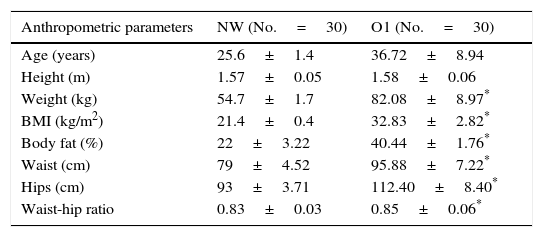Obesity is characterised by a generalised increase of adipose tissue, high production of adipocytokines and presence of oxidative systemic stress. The objective of this study was to evaluate the changes generated in the oxidative stress and anthropometric parameters in obese subjects by the prescription of a hypocaloric diet in combination with moderate aerobic exercise and supplementation with antioxidants.
Patients and methodsOxidative damage was determined in the plasma from 30 normal weight and 30 obese subjects. Three groups of treatment were established: hypocaloric diet (HD), HD plus moderate aerobic exercise (HDE) and HDE plus antioxidants (DHEA). Biomarkers of oxidative stress (thiobarbituric acid reactive substances [TBARS], carbonyl groups, dityrosine) and anthropometric parameters were determined.
ResultsHigher values of biomarkers of oxidative damage were observed in obese (TBARS 13.74±1.2μM; carbonyl groups 0.89±0.04nmol of osazone/mg of protein; dityrosine 478.9±27.4RFU/mg of protein) in comparison to normal weight subjects (TBARS 7.08±0.8μM; carbonyl groups 0.65±0.04nmol of osazone/mg of protein; dityrosine 126.3±12.6RFU/mg of protein), thus showing the presence of an oxidative damage. The prescription of HD decreased the oxidative damage and anthropometric parameters in the obese subjects. We did not observe additional benefit effects on these determinations with HDE or HDEA treatments.
ConclusionsWe demonstrated that an HD decreases the oxidative damage in obese subjects. Oxidative stress is an important factor in the development of comorbidity in obesity. Therefore, the prescription of a HD could be a key issue in the treatment of the disease.
La obesidad se caracteriza por un aumento generalizado de tejido adiposo, alta producción de adipocitocinas y presencia de estreés oxidativo sistémico. El objetivo de este estudio fue evaluar los cambios generados en el estrés oxidativo y los parámetros antropométricos en sujetos obesos por la prescripción de una dieta hipocalórica en combinación con ejercicio aeróbico moderado y suplementación con antioxidantes.
Pacientes y métodosEl daño oxidativo fue determinado en el plasma de 30 sujetos con normopeso y 30 sujetos obesos. Se consideraron 3 grupos de tratamiento: dieta hipocalórica (DH), DH más ejercicio aeróbico moderado (DHE), y DHE más antioxidantes (DHEA). Se determinaron biomarcadores de daño oxidativo (compuestos reactivos al ácido tiobarbitúrico [CRAT], grupos carbonilo, ditirosinas) y valores de parámetros antropométricos.
ResultadosSe observaron valores incrementados en biomarcadores de daño oxidativo en sujetos obesos (13.74±1.2μM, carbonilos 0,89±0,04nmoles de osazonas/mg de proteína, ditirosinas 478,9±27,4URF/mg de proteína) en comparación con sujetos con normopeso (CRAT 7,08±0,8μM, carbonilos 0,65±0,04nmoles de osazonas/mg de proteína, ditirosinas 126,3±12,6URF/mg de proteína), demostrando la presencia de un daño oxidativo. La prescripción de DH disminuyóel daño oxidativo y los parámetros antropométricos en el sujeto obeso. No se observaron efectos benéficos adicionales en estas determinaciones con los tratamientos DHE o DHEA.
ConclusionesDemostramos que una DH reduce el daño oxidativo en sujetos obesos. El estrés oxidativo es un factor importante en el desarrollo de comorbilidades en obesidad. Por lo tanto, la prescripción de una DH podría ser un punto clave en el tratamiento de la enfermedad.











